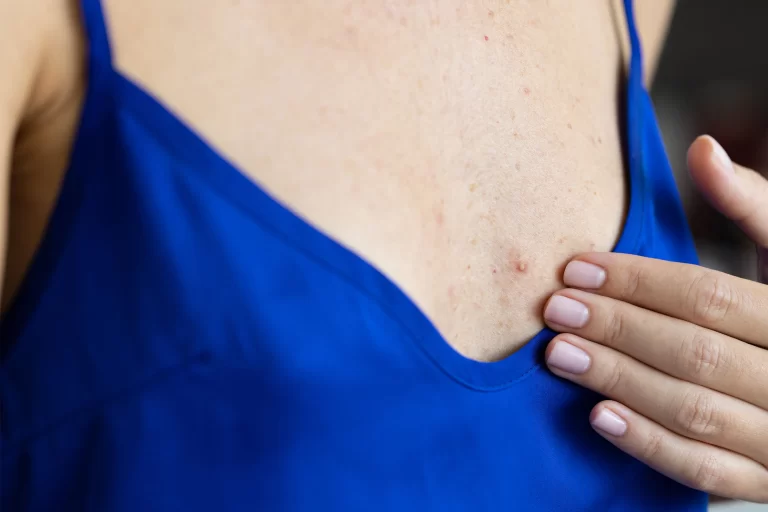Wichtige Punkte
- Breast acne is common and often triggered by friction, sweat, hormones, or clogged pores.
- Proper hygiene, breathable clothing, and dermatologist-approved skincare can help prevent breakouts.
- Treatments range from over-the-counter solutions to prescription options; sensitive skin in this area requires care.
- Knowing when to see a health professional is key—especially if symptoms persist, worsen, or cause scarring.
When Acne Shows Up in an Unexpected Place
Most people expect the occasional breakout on their face or back. But when acne appears on the breasts, it can catch you off guard—often stirring confusion and discomfort. It’s not a topic many openly discuss, yet dermatologists confirm that breast acne is more common than people realize, particularly in individuals who sweat frequently, wear tight clothing, or experience hormonal fluctuations (American Academy of Dermatology, 2023).
Because the chest and breast area are frequently covered, heat and sweat build-up can go unnoticed until red bumps, clogged pores, or painful pimples emerge. The surprise factor alone can make it feel more frustrating—and more difficult to manage.
But here’s the good news: once you understand the unique triggers and sensitivities of this area, managing breast acne becomes much more straightforward. Whether you’re dealing with occasional flare-ups or persistent breakouts, a thoughtful, science-backed approach can help you take back control.
Why It Happens: The Breast-Acne Breakdown
Like acne on the face or back, breast breakouts start when pores become clogged with oil, dead skin cells, or bacteria. The difference lies in the environment.
- Sweat glands are dense on the chest, especially under the breasts, which makes this area more prone to clogged pores when combined with heat and friction (Mayo Clinic, 2024).
- Clothing friction—especially from tight sports bras or synthetic fabrics—can trigger what’s known as “acne mechanica,” a form of acne caused by pressure and rubbing (AAD, 2023).
- Hormonal shifts, particularly increases in androgens, can drive oil production in the skin and lead to more breakouts. This often occurs around menstruation, pregnancy, or menopause (Journal of the American Academy of Dermatology, 2022).
- Other skin symptoms like folliculitis (inflammation of hair follicles) or hidradenitis suppurativa (a chronic inflammatory skin symptom) can also be mistaken for acne, highlighting the importance of correct diagnosis (JAAD, 2021).
How to Spot It (And What It’s Not)
Signs of breast acne:
- Red or skin-colored bumps
- Blackheads or whiteheads near the chest or upper breast
- Tender or painful breakouts around hormonal changes
It might not be acne if:
- The bumps are itchy and appear after shaving (possible folliculitis)
- You’ve changed laundry detergent or body lotion and now have a rash (possible contact dermatitis)
- You’ve been sweating heavily in a hot climate (possible heat rash)
A dermatologist can help distinguish between these based on pattern, timing, and appearance.
Prevention First: Habits That Make a Difference
Prevention begins with adjusting your environment and habits. Dermatologists recommend the following:
✔ Wear breathable fabrics
Switch to loose-fitting clothing made of cotton or moisture-wicking materials. Tight clothing traps sweat, which contributes to clogged pores and irritation (AAD, 2023).
✔ Cleanse gently after sweating
Use a mild body wash with salicylic acid (BHA) or benzoyl peroxide to help keep pores clear. Studies have shown that 2% salicylic acid can effectively reduce acne lesions by reducing inflammation and exfoliating the skin surface (PubMed, 2015).
✔ Exfoliate strategically
Gentle exfoliation using alpha hydroxy acids (like glycolic acid) once or twice a week can remove dead skin buildup, but overdoing it can cause more irritation—especially in sensitive areas.
✔ Wash bras and sheets often
Sweat, body oils, and skincare product residue on fabrics can lead to repeated breakouts if not cleaned regularly.
✔ Choose non-comedogenic products
Many body lotions, oils, and even sunscreen contain ingredients that clog pores. Look for labels that say “non-comedogenic” and “fragrance-free,” particularly for products used near the breast area.
Solutions That Work: From OTC to Prescription
For mild to moderate cases, over-the-counter (OTC) products may be enough. In more stubborn cases, prescriptions can help.
Topical Options
- Benzoyl peroxide (2.5%–5%) reduces acne-causing bacteria and inflammation. It’s effective but can bleach fabric and may be irritating if used too often (Mayo Clinic, 2024).
- Salicylic acid penetrates pores to clear debris and reduce inflammation.
- Topical retinoids, available by prescription, promote skin cell turnover and help prevent clogged pores—though they may be too strong for some users, especially on the thin skin of the breasts.
Oral Medications
- Hormonal therapy: Birth control pills or spironolactone help regulate oil production and are often prescribed for hormone-driven acne (JAAD, 2022).
- Oral antibiotics: Inflammatory acne may respond to short-term antibiotic use, but this is typically reserved for moderate to severe symptoms.
Natural Remedies: Proceed with Caution
Some natural ingredients may help—but proceed with care:
- Tea tree oil: Has antimicrobial properties, but should be diluted before use to avoid burning or irritation.
- Apple cider vinegar: Some use diluted ACV as a toner, but research is limited and the acidity can irritate sensitive skin.
- Zinc supplements: Emerging studies suggest oral zinc may help reduce acne, especially in those with deficiencies, but it should be used under medical guidance (PubMed, 2020).
Pregnancy, Breastfeeding, and Acne
Breast acne can become more noticeable during pregnancy and breastfeeding due to hormonal shifts. However, some common acne therapies—like retinoids and high-strength salicylic acid—should be avoided.
Dermatologists recommend:
- Gentle cleansing with non-medicated washes
- Colloidal oatmeal or aloe vera for calming inflammation
- Consulting a health professional before using any acne-targeting ingredients while pregnant or nursing (AAD, 2023)
When to See a Health Professional
You don’t have to wait until symptoms worsen. See a dermatologist if:
- Breakouts are painful, deep, or cystic
- The area becomes inflamed or bleeds
- You notice dark marks or scarring
- Over-the-counter solutions don’t improve symptoms after 6–8 weeks
Confidence Starts with Care
Acne on the breasts may not be openly discussed, but it’s a reality for many. With smart daily habits, the right skincare products, and—when needed—support from a health professional, managing breakouts becomes easier and less stressful. Your skin deserves thoughtful care, no matter where symptoms show up.
Der Artikel stellt in keiner Weise eine medizinische Beratung dar. Bitte konsultieren Sie einen zugelassenen Arzt, bevor Sie eine Behandlung beginnen. Diese Website kann Provisionen für die in diesem Artikel erwähnten Links oder Produkte erhalten.
Quellen
- American Academy of Dermatology (AAD). Acne: Signs, Causes, and Treatments. https://www.aad.org/public/diseases/acne
- Mayo-Klinik. Acne Causes & Risk Factors, 2024. https://www.mayoclinic.org/diseases-conditions/acne/symptoms-causes/syc-20368047
- Journal of the American Academy of Dermatology (JAAD). Hormonal acne management review. https://www.jaad.org/
- PubMed. “Evaluation of the Efficacy of Topical Salicylic Acid in Acne Vulgaris.” 2015. https://pubmed.ncbi.nlm.nih.gov/26120143/
- PubMed. “Zinc Therapy in Dermatology: A Review.” 2020. https://pubmed.ncbi.nlm.nih.gov/31989928/
Last Updated on August 1, 2025



